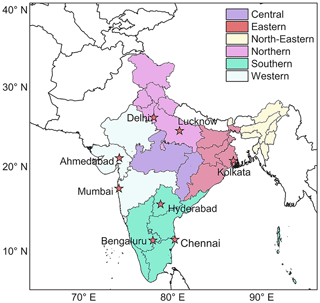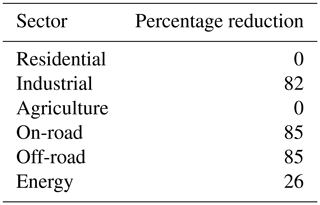the Creative Commons Attribution 4.0 License.
the Creative Commons Attribution 4.0 License.
Impact of reduced anthropogenic emissions during COVID-19 on air quality in India
Mengyuan Zhang
Arpit Katiyar
Shengqiang Zhu
Juanyong Shen
Jinlong Ma
Sri Harsha Kota
To mitigate the impacts of the pandemic of coronavirus disease 2019 (COVID-19), the Indian government implemented lockdown measures on 24 March 2020, which prohibited unnecessary anthropogenic activities, thus leading to a significant reduction in emissions. To investigate the impacts of this lockdown measure on air quality in India, we used the Community Multi-Scale Air Quality (CMAQ) model to estimate the changes of key air pollutants. From pre-lockdown to lockdown periods, improved air quality is observed in India, indicated by the lower key pollutant levels such as PM2.5 (−26 %), maximum daily 8 h average ozone (MDA8 O3) (−11 %), NO2 (−50 %), and SO2 (−14 %). In addition, changes in these pollutants show distinct spatial variations with the more important decrease in northern and western India. During the lockdown, our results illustrate that such emission reductions play a positive role in the improvement of air quality. Significant reductions of PM2.5 concentration and its major components are predicted, especially for secondary inorganic aerosols that are up to 92 %, 57 %, and 79 % for nitrate (NO), sulfate (SO), and ammonium (NH), respectively. On average, the MDA8 O3 also decreases 15 % during the lockdown period although it increases slightly in some VOC-limited urban locations, which is mainly due to the more significant reduction of NOx than VOCs. More aggressive and localized emission control strategies should be implemented in India to mitigate air pollution in the future.
- Article
(3137 KB) - Full-text XML
-
Supplement
(3598 KB) - BibTeX
- EndNote
India, the second-most populous country in the world, has been suffering from severe air pollution along with rapid urbanization and industrialization in recent decades (Karambelas et al., 2018), and 13 Indian cities were among the world's top 20 most polluted cities according to the World Health Organization (WHO) (WHO, 2018). High-level pollution leads to health risks and ecosystem damage, which caused 1.24 million deaths in India in 2017 (Balakrishnan et al., 2019) and a great loss of crops (Oksanen et al., 2013; Lal et al., 2017). To mitigate air pollution, the Indian government has been promoting effective emission control strategies such as the conversion of fossil fuels to clean fuels in the nationwide Clean India Mission (CIM). However, such long-term or short-term reduction strategies seem to show insufficiency in the restoration of ambient air quality (Beig et al., 2013; Purohit et al., 2019; Banerjee et al., 2017).
Due to the pandemic of coronavirus disease 2019 (COVID-19), nationwide or partial lockdown measures have been implemented in many countries (Chintalapudi et al., 2020; Dantas et al., 2020; Ehrlich et al., 2020). The Indian government declared corresponding bans since the detection of the first confirmed case on 30 January 2020. Then, to counter the fast contagion of COVID-19, a 3-week nationwide lockdown was imposed in India on 24 March, which was extended until 30 June. The lockdown measures mitigate the impact of COVID-19 on Indian health infrastructure and it also helped in curbing the rate of the spread of this infectious disease among people (Pai et al., 2020; Anderson et al., 2020). Because of the prohibition of industrial activities and mass transportation, anthropogenic emissions showed a tremendous reduction. As well as this, several studies showed that dramatic emission reductions had an enormous impact on the formation of air pollution and positively influenced air quality (Isaifan, 2020; Bao and Zhang, 2020; Gautam, 2020). Thus, the lockdown also provides a valuable opportunity to assess the changes in air pollutants with significantly reduced anthropogenic emissions in a short time.
Conspicuous reductions in concentrations of pollutants were also claimed in different regions (Otmani et al., 2020; Dantas et al., 2020; Nakada and Urban, 2020). Most Indian studies claimed the greatest reduction of particulate matter with an aerodynamic diameter of less than 2.5 µm (PM2.5), up to 50 % (Kumar et al., 2020; Mahato et al., 2020; Sharma et al., 2020). However, an increase in ozone (O3) concentrations was observed (Collivignarelli et al., 2020; Sicard et al., 2020) and severe air pollution events still occurred after large emission reductions due to unfavorable meteorological conditions (Wang et al., 2020). Moreover, another analysis showed that the effects of lockdown during the COVID-19 pandemic on PM2.5 and O3 pollution levels were smaller than the expected response to the enacted stay-at-home order (Bujin et al., 2020). Hence, the significance and impacts of lockdown measures are still not well understood.
Therefore, it is significant to understand the mechanisms involved in air pollution formation before and after dramatic emission changes comprehensively, in addition to the comparison of air pollution levels. Mahato et al. (2020) concluded that air quality in India from 24 March to 14 April improved sharply according to the change of the National Air Quality Index, especially for Delhi. Srivastava et al. (2020) reported the concentrations of primary air pollutants were drastically lowered as a result of emission reductions. Kumari and Toshniwal (2020) also stated that the concentration of key pollutants such as PM2.5 in both Delhi and Mumbai shows a decreasing trend. These studies pointed out that the air quality was improved during the lockdown period compared with the period before lockdown and depends on the duration of the lockdown (Kumar et al., 2020; Mor et al., 2021). As well as this, compared with the same period in previous years, Gautam (2020) claimed that aerosol concentration levels are at their lowest in the last 20 years during lockdown based on satellite data. Selvam et al. (2020) stated that the Air Quality Index (AQI) was improved by 58 % in Gujarat state in western India during lockdown (24 March–20 April 2020) compared to 2019. Kabiraj and Gavli (2020) concluded that the mean concentration of PM2.5 decreased by 42.25 % from January to May in 2020 compared with 2019. Similarly, Das et al. (2020) also showed that great reductions of PM2.5 were found across cities in the Indo-Gangetic Plain (IGP) compared with 2018 and 2019. However, the role of meteorological conditions and chemical reactions involving changes in air quality is not clear from these observation-based studies, which only showed the phenomenon of concentration reduction and switch of major primary pollutants mainly in urban cities. Further, the number of monitoring stations in the country is way below the guidelines given by the governing bodies and not uniformly distributed, which results in observation data limitations in India (Sahu et al., 2020).
In this study, the Community Multi-Scale Air Quality (CMAQ) model was used to investigate changes in air pollutants before the lockdown (from 21 February to 23 March 2020) and during the lockdown (from 24 March to 24 April 2020) periods throughout the Indian region. We explored the synergetic impacts from the meteorological conditions and anthropogenic emissions during the pre-lockdown and lockdown periods. As well as this, we directly quantified the change in air quality during the lockdown due to the reduced anthropogenic emissions by comparing the differences between Case 1 (without emission reductions) and Case 2 (with emission reductions). The model performance was evaluated by comparing the simulation results with the observation data, which is collected by the Central Pollution Control Board (CPCB). This study has important implications for developing control strategies to improve air quality in India.
2.1 Data collection
We used observed hourly PM2.5, O3, carbon monoxide (CO), and nitrogen dioxide (NO2) data from 21 February to 24 April 2020 from the CPCB online database (https://app.cpcbccr.com/ccr/#/caaqm-dashboard-all/caaqm-landing, last access: 20 January 2021), which is widely applied in previous studies (Kumar, 2020; Sharma et al., 2020; Srivastava et al., 2020; Shehzad et al., 2020). The CPCB database provides data quality assurance (QA) or quality control (QC) programs by establishing strict procedures for sampling, analysis, and calibration (Gurjar et al., 2016). As well as this, the observed daily averages of PM2.5 and maximum daily 8 h average ozone (MDA8 O3) have been further calculated to analyze the change in air quality during the pre-lockdown (from 21 February to 23 March 2020) and lockdown (from 24 March to 24 April 2020). The satellite-observed NO2 and formaldehyde (HCHO) column number density datasets are from the Sentinel-5 Precursor TROPOspheric Monitoring Instrument (S-5P TROPOMI) (https://scihub.copernicus.eu, last access: 7 February 2021). As well as this, we effectively removed the pixels with a QA value less than 0.75 for NO2 tropospheric column density and 0.5 for HCHO from the datasets to exclude the interferences such as clouds and snow or ice (Apituley et al., 2018).
2.2 Model description
This study applied CMAQ (Byun and Schere, 2006) version 5.0.2 with an updated SAPRC-11 photochemical mechanism (Carter, 2011; Hu et al., 2016) and aerosol module (AERO6) (Binkowski and Roselle, 2003) to simulate air pollution across India with a horizontal resolution of 36 km × 36 km (117 × 117 grid cells). Figure 1 shows the simulation domain with positions of the main Indian cities. The simulation was conducted from 21 February to 23 March as a pre-lockdown and 24 March to 24 April as a lockdown period.
The Weather Research & Forecasting model (WRF) version 3.6.1 was utilized to generate meteorology fields driven by the latest FNL (Final) Operational Global Analysis data. Anthropogenic emissions were from the monthly data from the Emissions Database for Global Atmospheric Research (EDGAR) version 4.3 (http://edgar.jrc.ec.europa.eu/overview.php?v=431, last access: 20 September 2020). The monthly emissions from different source sectors were divided into six major groups, residential, industrial, agriculture, on-road, off-road, and energy, before being adjusted from the base year of 2010 to 2019 based on population and economic growths similar to Guo et al. (2017), and the adjustment factors are shown in Tables S1–S3 in the Supplement. Weekly and diurnal profiles were used to convert monthly emissions to hourly inputs, and the US EPA's SPECIATE 4.3 source profiles were used to speciate total particulate matter (PM) and volatile organic compounds (VOCs) to model species (Wang et al., 2014).
The biogenic emissions were derived from The Model of Emissions of Gases and Aerosols from Nature (MEGAN) version 2.1 (Guenther et al., 2012), and the emissions from biomass burning for 2018 were based on the Fire Inventory from the National Center for Atmospheric Research (FINN) (Wiedinmyer et al., 2011).
2.3 Emission reduction during COVID-19
Due to the COVID-19 lockdown, human activities were limited and related anthropogenic emissions were reduced. Different sources were used to obtain changes in anthropogenic emissions from different sectors in comparison to 2019.
For the sectors of on-road and off-road, the vehicle emission changes were based on the number of registered vehicles verified from the article (ET Bureau, 2020). The changes in energy demand were obtained from official data released by the Power System Operation Corporation (POSOCO) (Abdi, 2020). Residential and agricultural emissions remain unchanged due to a lack of sufficient information.
For the industrial sector, we classify the Indian industries into three different classes based on the degree of air pollution caused (https://www.indianmirror.com/indian-industries/environment.html, last access: 7 February 2021) (Table S4) including very polluting (VP), medium polluting (MP), and low polluting (LP) industries. The pollution index (PI) of any industry is a number ranging from 0 to 100 and the increasing value of PI denotes the increasing degree of pollution load from the industry. As well as this, CPCB, State Pollution Control Boards (SPCBs), and the Ministry of Environment, Forest and Climate Change (MoEFCC) have finalized the criteria on the range of PI for the purpose of categorization of the industrial sector (https://pib.gov.in/newsite/printrelease.aspx?relid=137373, last access: 7 February 2021) (Table 1).
Table 1The criteria on the “range of pollution index” for the purpose of categorization of industrial sectors.
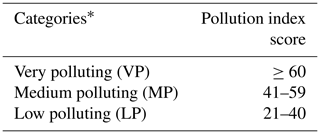
Note: ∗ VP, MP, and LP industries are also defined as the red, orange, and green categories of industrial sectors respectively, based on the Indian Ministry of Environment, Forest and Climate Change website (https://pib.gov.in/newsite/printrelease.aspx?relid=137373).
Based on the above definition of the VP, MP, and LP industry, the emissions before lockdown can be expressed as follows:
where SVP, SMP, and SLP are 1, 0.6, and 0.4 as the assigned scores, and NVP-pre, NMP-pre, and NLP-pre are the number of each category industry before the lockdown. Similarly, the emissions during the lockdown are as follows:
where NVP-lock, NMP-lock, and NLP-lock are the number of functioning industries during the lockdown. Therefore, the percentage reduction of industrial emissions can be calculated as follows:
In this study, two sensitivity simulations were conducted during the lockdown periods. Case 1 assumes business as usual with the same emissions as in 2019, while Case 2 adjusts anthropogenic emissions using factors obtained above for different sectors (Table 2). The differences between Case 2 and Case 1 can be assumed as the effects of COVID-19 lockdowns.
3.1 WRF-CMAQ model validation
Meteorology plays an important role in emissions, transport, deposition, and formation of air pollutants (Zhang et al., 2015). Hence, the performance of WRF is validated to ensure accurate air pollution simulation against available observation from the National Climate Data Center (NCDC). There are more than 1300 stations within the simulation domain with hourly observations. The variables considered include temperature at 2 m above the surface (T2), wind speed (WS), wind direction (WD), and relative humidity (RH). Table S5 shows the statistics of mean observation and mean prediction of meteorological parameters, along with mean bias (MB), gross error (GE), and root mean squared error (RMSE), which are compared to benchmarks suggested by Emery et al. (2001). All the statistical indexes are listed in Table S6.
In general, the WRF model performance is similar to previous studies in India (Kota et al., 2018). For the pre-lockdown and lockdown period, predicted T2 was under-estimated with MB values of −1.5 and −1.2 K, respectively. The GE values for WS were 1.7 % (pre-lockdown) and 1.8 % (lockdown), satisfying the suggested criteria of 2.0 %, and RMSE was slightly over the criteria. The MB values for WD were 3.2 and 2.6∘ during the two periods, which are within the criteria of ±10∘. The GE and RMSE for WD were slightly out of the benchmarks. The under-predicted RH was also observed in this study, which was reported in other Asian studies (Hu et al., 2015). Those statistic values that did fall in the benchmark were mainly due to the resolution (36 km) applied in this study compared to the finer resolution (4–12 km) suggested in Emery et al. (2001) and Sahu et al. (2020).
Table S7 shows the model performance of MDA8 O3, PM2.5, CO, and NO2 in five major cities in India including Delhi, Mumbai, Chennai, Hyderabad, and Bengaluru. For PM2.5, after excluding some abnormally high values of greater than 300 µg m−3, the averaged mean fractional bias (MFB) (−0.48) and mean fractional error (MFE) (0.61) values in all the five urban cites met the criteria limits of ±0.6 and 0.75 claimed by the EPA (2007). And the recommended criteria are commonly used for validating air quality model performance in the Indian region (Mohan and Gupta, 2018; Kota et al., 2018). For O3, a cut-off value of 40 ppb is applied, which is based on EPA's recommendations (EPA, 2005). As well as this, the model was able to reproduce the variation trends of observed hourly O3 in all these major cities, although slightly over-estimations have occurred. And averaged MFB (−0.05) and MFE (0.25) values of O3 also satisfy the benchmarks of ±0.15 and 0.30 set by the EPA (2005) in most of these cities with Chennai and Hyderabad exceeding the limits slightly. The performance of PM2.5, NO2, O3, and CO in these urban areas was also similar to Kota et al. (2018), which could provide robust results for the following air quality study.
To further validate modeled HCHO and NO2, we compared our simulated results with satellite-observed data during pre-lockdown and lockdown periods (Fig. S1). The CMAQ predicted vertical column densities (VCDs) of tropospheric NO2 and HCHO were calculated using Eq. (4) (Eskes et al., 2020).
where n equals 17 as the number of vertical layers in the model (with the highest layer height of ∼ 10 km), Ci means species concentration (ppm), Hi represents each layer height (m), and α is the coefficient for converting units from ppm to molec. cm−2. The predicted regional distribution of tropospheric column NO2 and HCHO is similar to satellite observations. Overall, HCHO and NO2 are higher in eastern and northern India than in other regions. And their variation trends from CMAQ and TROPOMI are consistent so that NO2 decreases while HCHO increases during the lockdown. We also acknowledge that the uncertainty of the emission inventory and chemical mechanism in the modeling may affect the simulated results (Dominutti et al., 2020; Kitayama et al., 2019).
3.2 Changes in air quality from pre-lockdown to lockdown periods
Figure 2 shows predicted and observed PM2.5 from 21 February to 24 April in Delhi, Mumbai, Chennai, Hyderabad, and Bengaluru. The model succeeds in estimating the observed peak and valley values with slight under-estimation in all these cities. Overall, sharp decreases are found in the observed PM2.5 in all these cities, and the averaged PM2.5 level drops from 43.18 to 27.62 µg m−3. The mean observed PM2.5 concentrations during lockdown are 42.47 µg m−3 (Delhi), 24.53 µg m−3 (Mumbai), 15.73 µg m−3 (Chennai), 31.29 µg m−3 (Hyderabad), and 24.08 µg m−3 (Bengaluru), which are reduced by 41 %, 40 %, 42 %, 10 %, and 43 % respectively compared with that of the pre-lockdown period. As well as this, the observed peak values of PM2.5 in each city also decrease appreciably (up to 57 %) during the lockdown period. On 24 March, the first day of lockdown, a significant drop in PM2.5 concentration due to the emission reduction of primary pollutants is observed (Fig. S2). However, most of the PM2.5 concentrations are still above the WHO annual guideline values of 10 µg m−3 (WHO, 2016) during the lockdown period, with peak values over 60 µg m−3 occasionally.
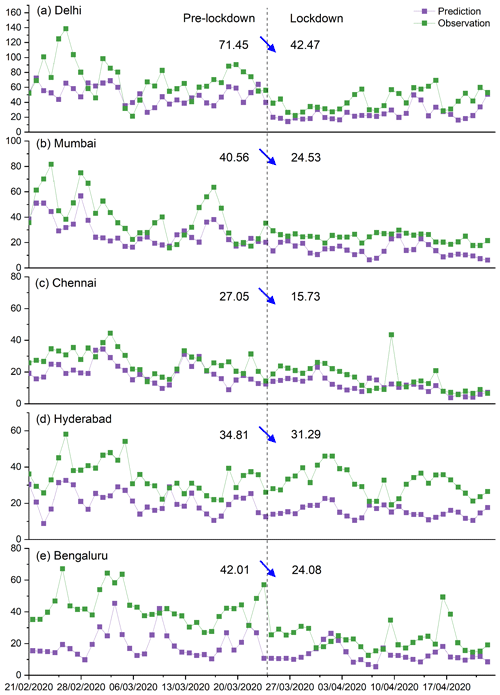
Figure 2Comparison of predicted and observed PM2.5 from 21 February to 24 April 2020 in Delhi, Mumbai, Chennai, Hyderabad, and Bengaluru. The unit is µg m−3.
Figure 3 shows the temporal variation of MDA8 O3 in these five cities. The predicted MDA8 O3 is consistent in trend with observation values on most days, while simulated concentrations are overall higher, particularly in Hyderabad. The observed average MDA8 O3 during lockdown is higher than that before the lockdown in Delhi (2 %), Hyderabad (12 %), and Bengaluru (2 %). This is likely due to the fact that O3 formation in these cities is under VOC control (Sharma et al., 2020), and a nitrogen oxide (NOx) reduction leads to an O3 increase by enhanced hydrogen oxide radical (HOx) concentrations (Zhao et al., 2017). The increase in monthly average T2 from before the lockdown (281.0 K) to lockdown (285.1 K) could also lead to an increase in O3 (Chen et al., 2019). In contrast, the observed average MDA8 O3 during lockdown is reduced compared with the pre-lockdown period in both Mumbai (−35 %) and Chennai (−13 %). This could be caused by a much larger reduction in emissions as Mumbai and Chennai with high urbanization and industrialization are the most affected areas. Specifically, more stringent lockdown measures may be implemented in Mumbai than we assumed, which accounted for more than a fifth of infections in India (Mukherjee, 2020).
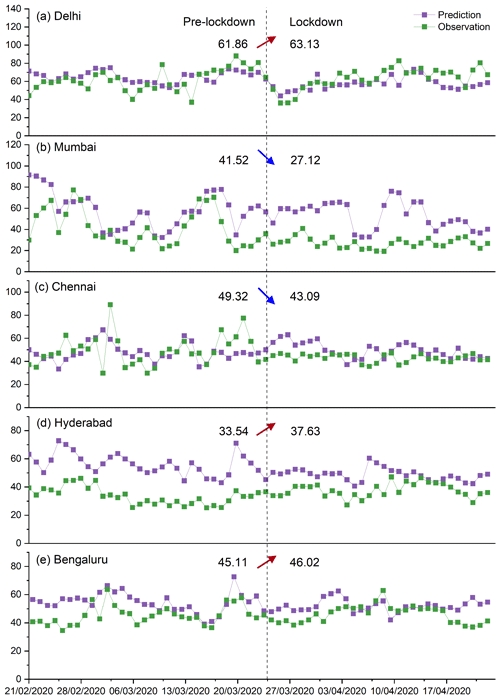
Figure 3Comparison of predicted and observed MDA8 O3 from 21 February to 24 April 2020 in Delhi, Mumbai, Chennai, Hyderabad, and Bengaluru. The unit is ppb.
Figure 4 shows the comparison of predicted air pollutants before and during the lockdown throughout India. Generally, decreases in key pollutants including particulate matter with an aerodynamic diameter of less than 10 µm (PM10) (−16 %), PM2.5 (−26 %), MDA8 O3 (−11 %), NO2 (−50 %), and sulfur dioxide (SO2) (−14 %) are calculated across India. Changes in these pollutants present distinct regional variations. In northern and western India, the lower levels of these pollutants are observed during the lockdown, with reductions of PM2.5 and PM10 of up to 79 %. In particular, the most significant decreases during the lockdown are found in the populated, industrialized, and polluted IGP region. The average PM2.5 even drops from approximately 35–70 µg m−3 (pre-lockdown) to 15–40 µg m−3 (lockdown) in these regions because local emissions are generally the largest contributor (38 %–78 %) to PM2.5 in India (David et al., 2019). However, increases in these key pollutants are found mainly in the northeastern, eastern, and parts of southern India.
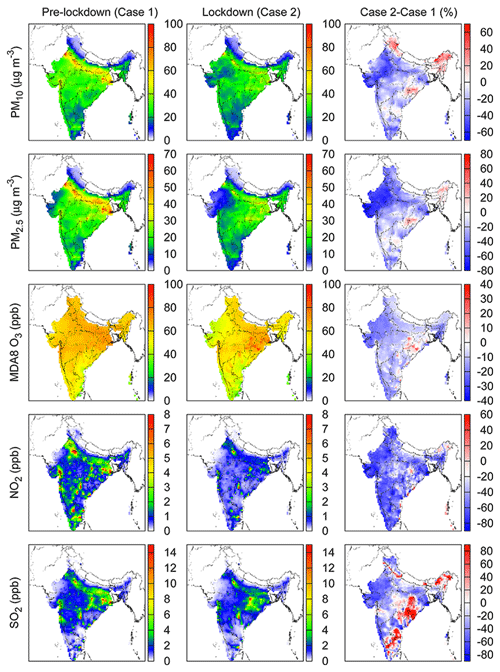
Figure 4Predicted PM10 (µg m−3), PM2.5 (µg m−3), MDA8 O3 (ppb), NO2 (ppb), and SO2 (ppb) before lockdown, during the lockdown and the changes between them in India. “Case 2 − Case 1” indicates (Case 2 − Case 1) Case 1, reported as %.
As well as this, changes in PM2.5 also show prominent differences in the rural and urban areas. In India, rural areas have different emission sources from urban areas and are less influenced by lockdown measures (Garaga et al., 2020). In megacities such as Delhi, the predicted concentrations of PM2.5 declined during the lockdown, which is consistent with previous results (Kumari and Toshniwal, 2020; Chauhan and Singh, 2020). For instance, a reduction of over 60 % in PM2.5 is estimated in Delhi and Ahmedabad. However, increases in PM2.5 (∼ 20 %) are observed in the remote northeastern part of India. Variations in near-surface meteorological factors during lockdown also play an important role in PM2.5 changes. As is shown in Fig. S3, lower PM2.5 in urban areas during lockdown (Fig. 4) may be attributed to the decrease in RH and increase in planetary boundary layer (PBL) height, while the decrease in precipitation and WS allows PM2.5 to accumulate in some rural areas (Schnell et al., 2018; Le et al., 2020).
As gaseous precursors of major components to PM2.5 (Jain et al., 2020), concentrations of NO2 and SO2 also decrease significantly in most regions by up to 90 % and 87 %, respectively. However, their levels increase in parts of eastern and southern India, thus leading to higher levels of PM2.5 and PM10 in the same regions. MDA8 O3 is also rising in eastern India by the highest increasing rate of 29 %, while a 30 % reduction is observed in northern and western India. Although significant reductions are found in O3 precursor emissions throughout India during the lockdown, the MDA8 O3 has not shown a comparable decrease, which is affected by meteorological conditions such as an increase in temperature and decrease in RH (Fig. S3). Higher temperatures speed up photochemical processes that produce O3, while a higher RH reduces them (Chen et al., 2019; Zhao et al., 2017; Ali et al., 2012).
In summary, the decrease in PM2.5, PM10, NO2, and SO2 and the increase in MDA8 O3 during lockdown are consistent with previous results (Srivastava et al., 2020; Mahato et al., 2020). In the case of Delhi, compared with the previous studies, the PM2.5 reduction (34 %) is comparable with 35 % reported by Chauhan and Singh (2020), with less than 53 % stated by Mahato et al. (2020) and 49 % calculated by Kumari and Toshniwal (2020) during the first phase of lockdown (from 24 March to 15 April 2020). These differences may be caused by the considered duration of the lockdown period. Our study concerns the later lockdown period (after 15 April 2020) when there is an increase in traffic flow and some relaxation of lockdown measures (Kumar, 2020). Moreover, the different characteristics of these air pollutants in rural and urban areas have not been investigated comprehensively in previous studies. Kumari and Toshniwal (2020) also concluded that concentrations of PM10, PM2.5, and SO2 tended to rise in Singrauli (rural area, located in central India) during the lockdown, contrary to the results of Delhi and Mumbai. Therefore, our results have important implications for the study of air quality changes and their regional distribution across India and indicate more strident emission reduction policies should be implemented across India, especially in the later phases of lockdown and in rural areas.
3.3 Effects of emission reductions on PM2.5 during the lockdown
There are significant changes in PM2.5 between the lockdown and pre-lockdown periods. Moreover, we directly quantify the change in PM2.5 during the lockdown. Figure 5 shows the differences in major PM2.5 components during the lockdown period with (Case 2) and without (Case 1) control measures.
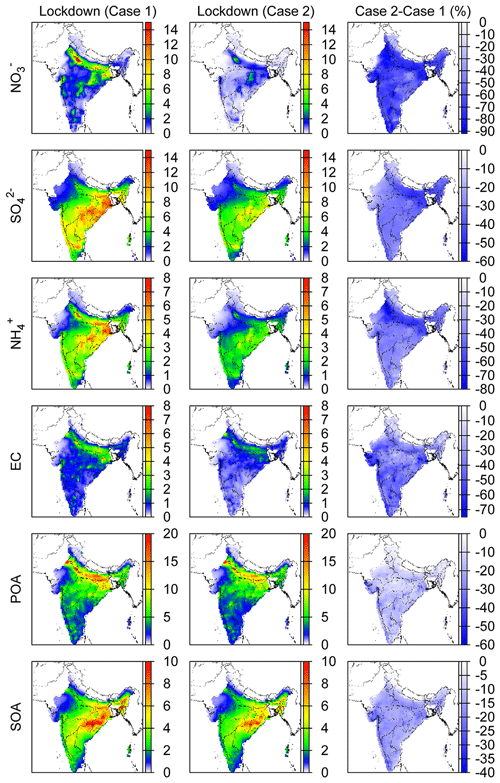
Figure 5Predicted PM2.5 components and the changes caused by lockdown measures from 24 March to 24 April 2020 in India. The unit is µg m−3. “Case 2 − Case 1” indicates (Case 2 − Case 1) Case 1, reported as %.
Major components of PM2.5 including nitrate (NO), sulfate (SO), ammonium (NH), elemental carbon (EC), primary organic aerosols (POAs), and secondary organic aerosols (SOAs) decreased significantly in Case 2 compared to Case 1, indicating the positive effects of emission reduction. Primary components of PM2.5 (EC and POAs) are lowered by an average of 37 % and 14 %, respectively. EC is usually emitted from combustion sources and a drastic decrease of up to 74 % directly reflected the impact of emission reductions from industry and transportation. Secondary inorganic aerosols (SIAs) including NO, SO, and NH and SOAs accounted for most of the PM2.5 bulk mass (39 %) and showed greater decreases than primary components. Moreover, the spatial distribution of SIAs is similar to PM2.5 in that the reduction is more significant in the north of India where the decrease in NO, SO, and NH are up to 92 %, 57 %, and 79 % respectively. The largest reduction of NO, averaging 62 %, resulted from transportation reduction, and the SO reduction (averaging 31 %) is likely due to the falling industry emissions (Gawhane et al., 2017; Wang et al., 2020). On average, NH and SOAs are decreased by 41 % and 14 %, respectively. The significant decrease in NH cannot be attributed to the absence of reduced agricultural emissions in the simulation but may be due to the relatively reduced (NH4)2SO4 and NH4NO3 in the CMAQ chemistry-transport model (Fountoukis and Nenes, 2007). By contrast, compared with VOCs, an important precursor of SOAs, the smaller reduction of SOAs may be related to the weakening of the atmospheric oxidizing capacity (AOC), which plays an important role in the formation of SOAs (Feng et al., 2019). As well as this, the reduction of NOx may lead to an increase in SOAs offsetting some of the influence by the reduction in VOC emissions (Kroll et al., 2020).
Figure 6 shows the predicted response of changes in concentration of primary PM2.5 (PPM) and secondary components to the reduced emissions of related precursors in Delhi, Mumbai, Kolkata, Bengaluru, Hyderabad, Chennai, Ahmedabad, and Lucknow. Generally, all species decreased with the reduced emissions and the great sensitivity of PM2.5 component concentrations to emissions showed the important role of meteorology and the effectiveness of stringent measures to reduce emissions.
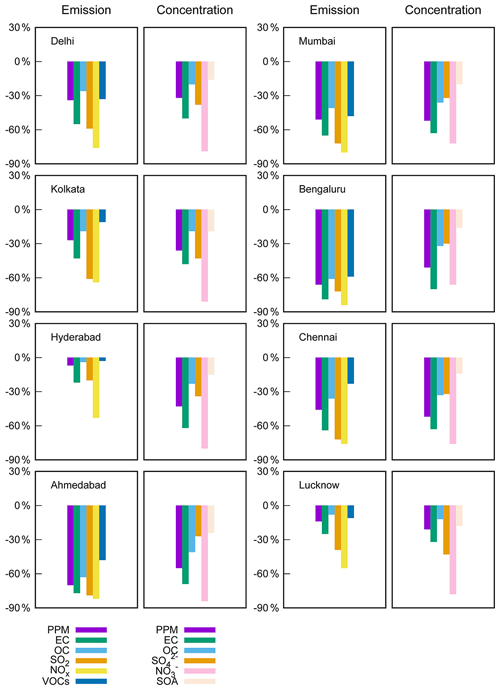
Figure 6Predicted relative changes in concentrations of primary and secondary components, and emissions of their precursors in eight cities of India in Case 2 to Case 1.
On average, NO shares the largest reduction of 77 % mainly driven by the decrease in its gaseous precursor NOx (71 %). At least a 27 % decrease in SO is found in each city caused by the largest reduction of SO2 (averaged 59 %). An average reduction of over 70 % in NOx and NO may still be related to the reduction of vehicles. And SOAs dropped by an average of 18 % because of the lack of precursors due to the emission reduction of VOCs (29 %). Due to the reduction of emitting precursors, the concentration reduction of PM2.5 secondary components is less than that of primary components. The ratios of PPM reduction in emission (averaged 39 %) are larger than the reduction in concentration (averaged 43 %) in five selected cities. In particular, a 7 % reduction in emission of PPM caused a 43 % decline in its concentration in Hyderabad. Emissions of EC and organic carbon (OC) have also been reduced by a certain proportion resulting in a similar or greater reduction in concentrations.
The response of concentration to emissions in all cities presented a nonlinear change that has been confirmed previously by Zhao et al. (2017), which is related to various meteorological conditions (Wang et al., 2020). For example, in Lucknow, PPM, EC, OC, SO2, NOx, and VOCs decreased by 14 %, 25 %, 8 %, 39 %, 55 %, and 11 % respectively, while the concentration of PPM, EC, OC, SO, NO, and SOAs dropped by 21 %, 32 %, 12 %, 43 %, 78 %, and 18 %. As well as this, the concentration response to emission reduction is likely to be more prominent in highly polluted and industrialized areas. The highest reductions in PPM and these secondary components of PM2.5 happened in Ahmedabad (an industrial city located in western India) with high vehicular populations. Bengaluru, a major southern Indian city, is considered as one of the cleaner Indian major cities because of its low PM2.5 concentrations with no heavy industries (Guttikunda et al., 2019). Consequently, the reduction in PM2.5 and its major components (especially for secondary components) in Bengaluru is not as significant as in Ahmedabad although a similar reduction in emissions is observed.
3.4 Effects of emission reductions on O3 during the lockdown
We investigated the changes of MDA8 O3 and its major precursors NOx and HCHO during the lockdown period. HCHO is one of the major contributors to total VOC reactivity (Zhang et al., 2012; Steiner et al., 2008). It also has a strong correlation with VOC (R2 up to 0.93) (Fig. S4) and performs well when validated by comparing with satellite-observed data. As a result, HCHO is used as a good proxy in the model for the total VOCs, consistent with previous studies such as Palmer et al. (2003). Figure 7 shows that MDA8 O3, NOx, and HCHO decreased all over India. The average reduction rates of MDA8 O3, NOx, and HCHO are approximately 15 %, 50 %, and 15 %, respectively. For both Case 1 and Case 2, the higher levels of MDA8 O3 are in eastern India (over 60 ppb, Case 1) in which the higher NOx is also observed (over 12 ppb, Case 1) during the lockdown. Compared to PM2.5, no significant north–south differences are found in the change of O3. The NOx concentration has the greatest reduction that is mostly driven by the large cutting of energy emission by 26 %, which is consistent with the decline of India's electricity consumption (9.2 %) (Reuters, 2020).

Figure 7Predicted O3, NOx, HCHO, and the changes caused by nationwide lockdown measures from 24 March to 24 April 2020 in India. The unit is ppb. “Case 2 − Case 1” indicates (Case 2 − Case 1) Case 1, reported as %.
Figure S5 shows the O3 production sensitivity (O3 NOy) in India during the lockdown, which is considered as an indicator of O3 sensitivity to NOx and VOCs (Sillman, 1995; Sillman and He, 2002). As well as this, O3 NOy < 6 indicates that O3 formation is VOC-limited, O3 NOy > 8 indicates NOx-limited, and intermediate values are transitional. In India, NOx-limited regimes are found in vast areas from both Case 1 and Case 2, which was also reported in previous studies (Mahajan et al., 2015). As a result, the large reduction of NOx leads to decreased MDA8 O3 in most Indian regions. Compared to Case 1, the VOC-limited area expands mainly in the northwest and south of India from Case 2 during the lockdown. Simultaneously, the rise of MDA8 O3 (averaged 5 % and up to 21 %) is found sporadically in these VOC-limited areas in which more significant decreases in NOx (compared with VOCs) reduce the O3 consumption (NO + O3 = NO2 + O2) and enhance HOx concentrations, resulting in an increase in O3 levels. It may also indicate that the increase in O3 is amplified regionally by the expansion of the VOC-limited regimes due to the lockdown.
Figure 8 compares the concentrations of MDA8 O3, HCHO, and NOx with emissions of VOCs, HCHO, and NOx in eight major cities of India, Delhi, Mumbai, Kolkata, Bengaluru, Hyderabad, Chennai, Ahmedabad, and Lucknow. Generally, the decline in O3 concentration in Delhi (14 %), Mumbai (23 %), Kolkata (24 %), Bengaluru (20 %), Hyderabad (17 %), Chennai (20 %), Ahmedabad (21 %), and Lucknow (15 %) showed that effectiveness of emission reductions that play an important role in the control of O3 pollution, even in these VOC-limited areas.
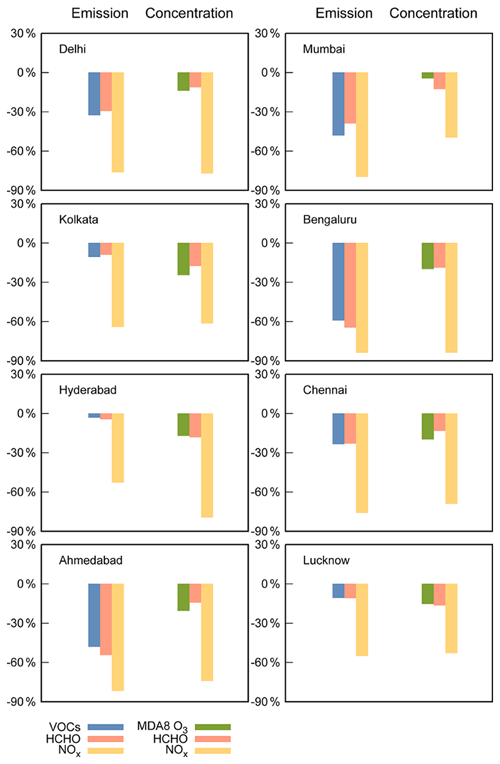
Figure 8Predicted relative changes in concentrations of O3, HCHO, and NOx and emissions of VOCs, HCHO, and NOx in eight major cities of India in Case 2 to Case 1.
The changes in emissions and concentrations of MDA8 O3, HCHO, and NOx showed a non-linear response. In Delhi, a 76 % reduction in NOx emissions resulted in a 77 % reduction in its concentration, while a 29 % reduction in HCHO resulted in only an 11 % reduction. In a megacity like Delhi, about 7 million vehicles and many fossil-fuel-based plants lead to high NOx emissions, and local restricted transportation and industrial activities during lockdown could lead to a significant reduction of primary NOx emissions (Sharma et al., 2016). The concentration of NOx is appreciably highly sensitive to a primary NOx emission reduction. However, the VOCs emission reduction resulting from the lockdown is relatively less than NOx in each city. And most of the reduction of HCHO concentration is less than that of emission reduction, which is different from NOx, which indicated that the change of HCHO concentrations is not dominated by primary HCHO emission reduction.
Compared with before the lockdown, observed PM2.5 during the lockdown in Delhi, Mumbai, Chennai, Hyderabad, and Bengaluru shows an overall decrease. In contrast, MDA8 O3 increases in three of these cities. The comparison of predicted air pollutants across India before and during the lockdown shows distinct regional characteristics. The most significant reductions of PM2.5 and PM10 (up to 79 %) are observed in most of northern and western India including all these megacities. However, increases in MDA8 O3 (up to 29 %) and other key pollutants are reported in northeastern, eastern, and parts of southern India covering most of the rural areas. As well as this, it can be concluded that the synergetic impact from the meteorological conditions and anthropogenic emissions plays an important role in those increases from pre-lockdown to lockdown periods.
The drastic decline in PM2.5 and its major components during the lockdown period in Case 2 compared with Case 1 shows the positive impacts of emission control measures, especially for SIAs. During the lockdown, the decrease in MDA8 O3 (averaged 15 %) occurs in most regions in India, which is attributed to the lower emissions of NOx (48 %) and VOCs (6 %) that are precursors of O3. Our results demonstrate that the strident emission controls due to the lockdown have mitigated air pollution in India. However, more stringent mitigation measures are needed to achieve effective control of air pollution from secondary air pollutants and their components, particularly in rural areas. We also find the scattered increases in MDA8 O3 (up to 21 %) in some urban locations in the VOC-limited areas due to the emission reduction. This indicates that a more localized control policy with the consideration of the O3 sensitivity regime should be implemented in India to improve the air quality, especially for secondary pollutants such as O3.
The datasets used in the study can be accessed from websites listed in the references or by contacting the corresponding authors (peng.ce.wang@polyu.edu.hk and zhanghl@fudan.edu.cn).
The supplement related to this article is available online at: https://doi.org/10.5194/acp-21-4025-2021-supplement.
MZ conducted the modeling and led the writing of the paper. AK carried out the data collection and initial analysis. SZ, JS, and JM assisted with the data analysis. MX and SHK assisted with the interpretation of the results and the writing of the paper. HZ and PW designed the study, discussed the results, and edited the paper.
The authors declare that they have no conflict of interest.
We acknowledge the publicly available WRF and CMAQ models that make this study possible.
This research has been supported by the Institute of Eco-Chongming (grant no. ECNU-IEC-202001).
This paper was edited by Frank Dentener and reviewed by three anonymous referees.
Abdi, B.: The Economic Times, Coronavirus impact: Within ten days, 26 per cent fall in India's energy consumption, available at: https://energy.economictimes.indiatimes.com/news/power/, last access: 27 August 2020.
Ali, K., Inamdar, S. R., Beig, G., Ghude, S., and Peshin, S.: Surface ozone scenario at Pune and Delhi during the decade of 1990s, J. Earth Syst. Sci., 121, 373–383, https://doi.org/10.1007/s12040-012-0170-1, 2012.
Anderson, R. M., Heesterbeek, H., Klinkenberg, D., and Hollingsworth, T. D.: How will country-based mitigation measures influence the course of the COVID-19 epidemic?, Lancet, 395, 931–934, https://doi.org/10.1016/s0140-6736(20)30567-5, 2020.
Apituley, A., Pedergnana, M., Sneep, M., Pepijn Veefkind, J., Loyola, D., Landgraf, J., and Borsdorff, T.: Sentinel-5 Precursor/TROPOMI Level 2 Product User Manual Carbon Monoxide, SRON-S5P-LEV2-MA-002, avaliable at: http://www.tropomi.eu/sites/default/files/files/Sentinel-5P-Level-2-Product-User-Manual-CarbonMonoxide_v1.00.02_20180613.pdf (last access: 7 February 2021), 2018.
Balakrishnan, K., Dey, S., Gupta, T., Dhaliwal, R. S., Brauer, M., Cohen, A. J., Stanaway, J. D., Beig, G., Joshi, T. K., Aggarwal, A. N., Sabde, Y., Sadhu, H., Frostad, J., Causey, K., Godwin, W., Shukla, D. K., Kumar, G. A., Varghese, C. M., Muraleedharan, P., Agrawal, A., Anjana, R. M., Bhansali, A., Bhardwaj, D., Burkart, K., Cercy, K., Chakma, J. K., Chowdhury, S., Christopher, D. J., Dutta, E., Furtado, M., Ghosh, S., Ghoshal, A. G., Glenn, S. D., Guleria, R., Gupta, R., Jeemon, P., Kant, R., Kant, S., Kaur, T., Koul, P. A., Krish, V., Krishna, B., Larson, S. L., Madhipatla, K., Mahesh, P. A., Mohan, V., Mukhopadhyay, S., Mutreja, P., Naik, N., Nair, S., Nguyen, G., Odell, C. M., Pandian, J. D., Prabhakaran, D., Prabhakaran, P., Roy, A., Salvi, S., Sambandam, S., Saraf, D., Sharma, M., Shrivastava, A., Singh, V., Tandon, N., Thomas, N. J., Torre, A., Xavier, D., Yadav, G., Singh, S., Shekhar, C., Vos, T., Dandona, R., Reddy, K. S., Lim, S. S., Murray, C. J. L., Venkatesh, S., and Dandona, L.: The impact of air pollution on deaths, disease burden, and life expectancy across the states of India: the Global Burden of Disease Study 2017, Lancet Planet. Health, 3, e26–e39, https://doi.org/10.1016/S2542-5196(18)30261-4, 2019.
Banerjee, T., Kumar, M., Mall, R. K., and Singh, R. S.: Airing 'clean air' in Clean India Mission, Environ. Sci. Pollut. Res., 24, 6399–6413, https://doi.org/10.1007/s11356-016-8264-y, 2017.
Bao, R. and Zhang, A.: Does lockdown reduce air pollution? Evidence from 44 cities in northern China, Sci. Total Environ., 731, 139052, https://doi.org/10.1016/j.scitotenv.2020.139052, 2020.
Beig, G., Chate, D. M., Ghude, S. D., Mahajan, A. S., Srinivas, R., Ali, K., Sahu, S. K., Parkhi, N., Surendran, D., and Trimbake, H. R.: Quantifying the effect of air quality control measures during the 2010 Commonwealth Games at Delhi, India, Atmos. Environ., 80, 455–463, https://doi.org/10.1016/j.atmosenv.2013.08.012, 2013.
Binkowski, F. S. and Roselle, S. J.: Models-3 Community Multiscale Air Quality (CMAQ) model aerosol component 1. Model description, J. Geophys. Res.-Atmos., 108, 4183, https://doi.org/10.1029/2001JD001409, 2003.
Bujin, B., Joshua, S. A., Dylan, B. M., Allen, R., Kelley, C. W., and Julian, D. M.: PM2.5 and Ozone Air Pollution Levels Have Not Dropped Consistently Across the US Following Societal Covid Response, ChemRxiv [preprint], https://doi.org/10.26434/chemrxiv.12275603.v3, 2020.
Byun, D. and Schere, K. L.: Review of the governing equations, computational algorithms, and other components of the models-3 Community Multiscale Air Quality (CMAQ) modeling system, Appl. Mech. Rev., 59, 51–77, https://doi.org/10.1115/1.2128636, 2006.
Carter, W. P. L.: SAPRC Atmospheric Chemical Mechanisms and VOC Reactivity Scales, available at: https://intra.engr.ucr.edu/~carter/SAPRC/ (last access: 26 August 2020), 2011.
Chauhan, A. and Singh, R. P.: Decline in PM2.5 concentrations over major cities around the world associated with COVID-19, Environ. Res., 187, 109634, https://doi.org/10.1016/j.envres.2020.109634, 2020.
Chen, Z., Zhuang, Y., Xie, X., Chen, D., Cheng, N., Yang, L., and Li, R.: Understanding long-term variations of meteorological influences on ground ozone concentrations in Beijing During 2006–2016, Environ. Pollut., 245, 29–37, https://doi.org/10.1016/j.envpol.2018.10.117, 2019.
Chintalapudi, N., Battineni, G., and Amenta, F.: COVID-19 virus outbreak forecasting of registered and recovered cases after sixty day lockdown in Italy: A data driven model approach, J. Microbiol. Immunol., 53, 396–403, https://doi.org/10.1016/j.jmii.2020.04.004, 2020.
Collivignarelli, M. C., Abba, A., Bertanza, G., Pedrazzani, R., Ricciardi, P., and Carnevale Miino, M.: Lockdown for CoViD-2019 in Milan: What are the effects on air quality?, Sci. Total Environ., 732, 139280, https://doi.org/10.1016/j.scitotenv.2020.139280, 2020.
Dantas, G., Siciliano, B., Franca, B. B., da Silva, C. M., and Arbilla, G.: The impact of COVID-19 partial lockdown on the air quality of the city of Rio de Janeiro, Brazil, Sci. Total Environ., 729, 139085, https://doi.org/10.1016/j.scitotenv.2020.139085, 2020.
Das, M., Das, A., Sarkar, R., Saha, S., and Mandal, A.: Examining the impact of lockdown (due to COVID-19) on ambient aerosols (PM2.5): A study on Indo-Gangetic Plain (IGP) Cities, India, Stoch. Env. Res. Risk A., 16, 1–17, https://doi.org/10.1007/s00477-020-01905-x, 2020.
David, L. M., Ravishankara, A. R., Kodros, J. K., Pierce, J. R., Venkataraman, C., and Sadavarte, P.: Premature Mortality Due to PM2.5 Over India: Effect of Atmospheric Transport and Anthropogenic Emissions, Geohealth, 3, 2–10, https://doi.org/10.1029/2018GH000169, 2019.
Dominutti, P., Nogueira, T., Fornaro, A., and Borbon, A.: One decade of VOCs measurements in São Paulo megacity: Composition, variability, and emission evaluation in a biofuel usage context, Sci. Total Environ., 738, 139790, https://doi.org/10.1016/j.scitotenv.2020.139790, 2020.
Ehrlich, H., McKenney, M., and Elkbuli, A.: Protecting our healthcare workers during the COVID-19 pandemic, Am. J. Emerg. Med., 38, 1527–1528, https://doi.org/10.1016/j.ajem.2020.04.024, 2020.
Emery, C., Tai, E., and Yarwood, G.: Enhanced Meteorological Modeling and Performance Evaluation for Two texas Episodes, Report to the Texas Natural Resources Conservation Commission, Prepared by ENVIRON, International Corp., Novato, CA, available at: http://www.tceq.state.tx.us/assets/public/implementation/air/am/contracts/reports/mm/EnhancedMetModelingAndPerformanceEvaluation.pdf (last access: 27 August 2020), 2001.
EPA: Guidance on the Use of Models and Other Analyses in Attainment Demonstrations for the 8-hour Ozone, NAAQSRep, available at: https://nepis.epa.gov/Exe/ZyPDF.cgi/P1006FPU.PDF?Dockey=P1006FPU.PDF, (last access: 27 August 2020), 2005.
EPA: Guidance on the use of models and other analyses for demonstrating attainment of air quality goals for ozone, PM2.5, and regional haze, US Environmental Protection Agency, Office of Air Quality Planning and Standards, available at: https://nepis.epa.gov/Exe/ZyPDF.cgi/P1009OL1.PDF?Dockey=P1009OL1.PDF (last access: 27 August 2020), 2007.
Eskes, K.-U. E., Lambert, J.-C., Loyola, D., Veefkind, J. P., Dehn, A., and Zehner, C.: S5P Mission Performance Centre Nitrogen Dioxide [L2_NO2_] Readme, available at: https://sentinel.esa.int/documents/247904/3541451/Sentinel-5P-Nitrogen-Dioxide-Level-2-Product-Readme-File (last access: 7 February 2021), 2020.
ET Bureau: The Economic Times, Move only essential items: Transport body to members, available at: https://economictimes.indiatimes.com/industry/transportation/shipping-/-transport/move-only-essential-items-transport-body-to-members/articleshow/75016374.cms?from=mdr, last access: 27 August 2020.
Feng, T., Zhao, S., Bei, N., Wu, J., Liu, S., Li, X., Liu, L., Qian, Y., Yang, Q., Wang, Y., Zhou, W., Cao, J., and Li, G.: Secondary organic aerosol enhanced by increasing atmospheric oxidizing capacity in Beijing–Tianjin–Hebei (BTH), China, Atmos. Chem. Phys., 19, 7429–7443, https://doi.org/10.5194/acp-19-7429-2019, 2019.
Fountoukis, C. and Nenes, A.: ISORROPIA II: a computationally efficient thermodynamic equilibrium model for K+–Ca2+–Mg2+–NH–Na+–SO–NO–Cl−–H2O aerosols, Atmos. Chem. Phys., 7, 4639–4659, https://doi.org/10.5194/acp-7-4639-2007, 2007.
Garaga, R., Gokhale, S., and Kota, S. H.: Source apportionment of size-segregated atmospheric particles and the influence of particles deposition in the human respiratory tract in rural and urban locations of north-east India, Chemosphere, 255, 126980, https://doi.org/10.1016/j.chemosphere.2020.126980, 2020.
Gautam, S.: The Influence of COVID-19 on Air Quality in India: A Boon or Inutile, B. Environ. Contam. Tox., 104, 724–726, https://doi.org/10.1007/s00128-020-02877-y, 2020.
Gawhane, R. D., Rao, P. S. P., Budhavant, K. B., Waghmare, V., Meshram, D. C., and Safai, P. D.: Seasonal variation of chemical composition and source apportionment of PM2.5 in Pune, India, Environ. Sci. Pollut. Res., 24, 21065–21072, https://doi.org/10.1007/s11356-017-9761-3, 2017.
Guenther, A. B., Jiang, X., Heald, C. L., Sakulyanontvittaya, T., Duhl, T., Emmons, L. K., and Wang, X.: The Model of Emissions of Gases and Aerosols from Nature version 2.1 (MEGAN2.1): an extended and updated framework for modeling biogenic emissions, Geosci. Model Dev., 5, 1471–1492, https://doi.org/10.5194/gmd-5-1471-2012, 2012.
Guo, H., Kota, S. H., Sahu, S. K., Hu, J., Ying, Q., Gao, A., and Zhang, H.: Source apportionment of PM2.5 in North India using source-oriented air quality models, Environ. Pollut., 231, 426–436, https://doi.org/10.1016/j.envpol.2017.08.016, 2017.
Gurjar, B. R., Ravindra, K., and Nagpure, A. S.: Air pollution trends over Indian megacities and their local-to-global implications, Atmos. Environ., 142, 475–495, https://doi.org/10.1016/j.atmosenv.2016.06.030, 2016.
Guttikunda, S. K., Nishadh, K. A., Gota, S., Singh, P., Chanda, A., Jawahar, P., and Asundi, J.: Air quality, emissions, and source contributions analysis for the Greater Bengaluru region of India, Atmos. Pollut. Res., 10, 941–953, https://doi.org/10.1016/j.apr.2019.01.002, 2019.
Hu, J., Wu, L., Zheng, B., Zhang, Q., He, K., Chang, Q., Li, X., Yang, F., Ying, Q., and Zhang, H.: Source contributions and regional transport of primary particulate matter in China, Environ. Pollut., 207, 31–42, https://doi.org/10.1016/j.envpol.2015.08.037, 2015.
Hu, J., Chen, J., Ying, Q., and Zhang, H.: One-year simulation of ozone and particulate matter in China using WRF/CMAQ modeling system, Atmos. Chem. Phys., 16, 10333–10350, https://doi.org/10.5194/acp-16-10333-2016, 2016.
Isaifan, R. J.: The dramatic impact of Coronavirus outbreak on air quality: Has it saved as much as it has killed so far?, Global J. Environ. Sci. Manage., 6, 275–288, https://doi.org/10.22034/gjesm.2020.03.01, 2020.
Jain, S., Sharma, S. K., Vijayan, N., and Mandal, T. K.: Seasonal characteristics of aerosols (PM2.5 and PM10) and their source apportionment using PMF: A four year study over Delhi, India, Environ. Pollut., 262, 114337, https://doi.org/10.1016/j.envpol.2020.114337, 2020.
Kabiraj, S. and Gavli, N. V.: Impact of SARS-CoV-2 Pandemic Lockdown on Air Quality Using Satellite Imagery with Ground Station Monitoring Data in Most Polluted City Kolkata, India, Aerosol Sci. Eng., 4, 320–330, 10.1007/s41810-020-00077-z, 2020.
Karambelas, A., Holloway, T., Kiesewetter, G., and Heyes, C.: Constraining the uncertainty in emissions over India with a regional air quality model evaluation, Atmos. Environ., 174, 194–203, https://doi.org/10.1016/j.atmosenv.2017.11.052, 2018.
Kitayama, K., Morino, Y., Yamaji, K., and Chatani, S.: Uncertainties in O3 concentrations simulated by CMAQ over Japan using four chemical mechanisms, Atmos. Environ., 198, 448–462, https://doi.org/10.1016/j.atmosenv.2018.11.003, 2019.
Kota, S. H., Guo, H., Myllyvirta, L., Hu, J., Sahu, S. K., Garaga, R., Ying, Q., Gao, A., Dahiya, S., Wang, Y., and Zhang, H.: Year-long simulation of gaseous and particulate air pollutants in India, Atmos. Environ., 180, 244–255, https://doi.org/10.1016/j.atmosenv.2018.03.003, 2018.
Kroll, J. H., Heald, C. L., Cappa, C. D., Farmer, D. K., Fry, J. L., Murphy, J. G., and Steiner, A. L.: The complex chemical effects of COVID-19 shutdowns on air quality, Nat. Chem., 12, 777–779, https://doi.org/10.1038/s41557-020-0535-z, 2020.
Kumar, P., Hama, S., Omidvarborna, H., Sharma, A., Sahani, J., Abhijith, K. V., Debele, S. E., Zavala-Reyes, J. C., Barwise, Y., and Tiwari, A.: Temporary reduction in fine particulate matter due to `anthropogenic emissions switch-off' during COVID-19 lockdown in Indian cities, Sustain. Cities Soc., 62, 102382, https://doi.org/10.1016/j.scs.2020.102382, 2020.
Kumar, S.: Effect of meteorological parameters on spread of COVID-19 in India and air quality during lockdown, Sci. Total Environ., 745, 141021, https://doi.org/10.1016/j.scitotenv.2020.141021, 2020.
Kumari, P., and Toshniwal, D.: Impact of lockdown measures during COVID-19 on air quality – A case study of India, Int. J. Environ. Health Res., https://doi.org/10.1080/09603123.2020.1778646, in press, 2020.
Lal, S., Venkataramani, S., Naja, M., Kuniyal, J. C., Mandal, T. K., Bhuyan, P. K., Kumari, K. M., Tripathi, S. N., Sarkar, U., Das, T., Swamy, Y. V., Gopal, K. R., Gadhavi, H., and Kumar, M. K. S.: Loss of crop yields in India due to surface ozone: an estimation based on a network of observations, Environ. Sci. Pollut. Res., 24, 20972–20981, https://doi.org/10.1007/s11356-017-9729-3, 2017.
Le, T., Wang, Y., Liu, L., Yang, J., Yung, Y. L., Li, G., and Seinfeld, J. H.: Unexpected air pollution with marked emission reductions during the COVID-19 outbreak in China, Science, 369, 702–706, https://doi.org/10.1126/science.abb7431, 2020.
Mahajan, A. S., De Smedt, I., Biswas, M. S., Ghude, S., Fadnavis, S., Roy, C., and van Roozendael, M.: Inter-annual variations in satellite observations of nitrogen dioxide and formaldehyde over India, Atmos. Environ., 116, 194–201, https://doi.org/10.1016/j.atmosenv.2015.06.004, 2015.
Mahato, S., Pal, S., and Ghosh, K. G.: Effect of lockdown amid COVID-19 pandemic on air quality of the megacity Delhi, India, Sci. Total Environ., 730, 139086, https://doi.org/10.1016/j.scitotenv.2020.139086, 2020.
Mohan, M. and Gupta, M.: Sensitivity of PBL parameterizations on PM10 and ozone simulation using chemical transport model WRF-Chem over a sub-tropical urban airshed in India, Atmos. Environ., 185, 53–63, https://doi.org/10.1016/j.atmosenv.2018.04.054, 2018.
Mor, S., Kumar, S., Singh, T., Dogra, S., Pandey, V., and Ravindra, K.: Impact of COVID-19 lockdown on air quality in Chandigarh, India: Understanding the emission sources during controlled anthropogenic activities, Chemosphere, 263, 127978, https://doi.org/10.1016/j.chemosphere.2020.127978, 2021.
Mukherjee, K.: COVID-19 and lockdown: Insights from Mumbai, Indian J. Pub. Health, 64, 168–171, https://doi.org/10.4103/ijph.IJPH_508_20, 2020.
Nakada, L. Y. K. and Urban, R. C.: COVID-19 pandemic: Impacts on the air quality during the partial lockdown in Sao Paulo state, Brazil, Sci. Total Environ., 730, 139087, https://doi.org/10.1016/j.scitotenv.2020.139087, 2020.
Oksanen, E., Pandey, V., Pandey, A. K., Keski-Saari, S., Kontunen-Soppela, S., and Sharma, C.: Impacts of increasing ozone on Indian plants, Environ. Pollut., 177, 189–200, https://doi.org/10.1016/j.envpol.2013.02.010, 2013.
Otmani, A., Benchrif, A., Tahri, M., Bounakhla, M., Chakir, E. M., El Bouch, M., and Krombi, M.: Impact of Covid-19 lockdown on PM10, SO2 and NO2 concentrations in Sale City (Morocco), Sci. Total Environ., 735, 139541, https://doi.org/10.1016/j.scitotenv.2020.139541, 2020.
Pai, C., Bhaskar, A., and Rawoot, V.: Investigating the dynamics of COVID-19 pandemic in India under lockdown, Chaos Soliton. Fract., 138, 109988, https://doi.org/10.1016/j.chaos.2020.109988, 2020.
Palmer, P. I., Jacob, D. J., Fiore, A. M., Martin, R. V., Chance, K., and Kurosu, T. P.: Mapping isoprene emissions over North America using formaldehyde column observations from space, J. Geophys. Res.-Atmos., 108, 4180, https://doi.org/10.1029/2002JD002153, 2003.
Purohit, P., Amann, M., Kiesewetter, G., Rafaj, P., Chaturvedi, V., Dholakia, H. H., Koti, P. N., Klimont, Z., Borken-Kleefeld, J., Gomez-Sanabria, A., Schopp, W., and Sander, R.: Mitigation pathways towards national ambient air quality standards in India, Environ. Int., 133, 105147, https://doi.org/10.1016/j.envint.2019.105147, 2019.
Reuters, S. V.: UPDATE 1 – India's March Electricity Usage Falls 9.2 % as Lock-Down Bites, available at: https://uk.reuters.com/article/india-electricity-supply/update-1-indias-march-electricity-usage-falls-9-2-as-lockdown, last access: 26 August 2020.
Sahu, S. K., Sharma, S., Zhang, H., Chejarla, V., Guo, H., Hu, J., Ying, Q., Xing, J., and Kota, S. H.: Estimating ground level PM2.5 concentrations and associated health risk in India using satellite based AOD and WRF predicted meteorological parameters, Chemosphere, 255, 126969, https://doi.org/10.1016/j.chemosphere.2020.126969, 2020.
Schnell, J. L., Naik, V., Horowitz, L. W., Paulot, F., Mao, J., Ginoux, P., Zhao, M., and Ram, K.: Exploring the relationship between surface PM2.5 and meteorology in Northern India, Atmos. Chem. Phys., 18, 10157–10175, https://doi.org/10.5194/acp-18-10157-2018, 2018.
Selvam, S., Muthukumar, P., Venkatramanan, S., Roy, P. D., Manikanda Bharath, K., and Jesuraja, K.: SARS-CoV-2 pandemic lockdown: Effects on air quality in the industrialized Gujarat state of India, Sci. Total Environ., 737, 140391, https://doi.org/10.1016/j.scitotenv.2020.140391, 2020.
Sharma, S., Chatani, S., Mahtta, R., Goel, A., and Kumar, A.: Sensitivity analysis of ground level ozone in India using WRF-CMAQ models, Atmos. Environ., 131, 29–40, https://doi.org/10.1016/j.atmosenv.2016.01.036, 2016.
Sharma, S., Zhang, M., Anshika, Gao, J., Zhang, H., and Kota, S. H.: Effect of restricted emissions during COVID-19 on air quality in India, Sci. Total Environ., 728, 138878, https://doi.org/10.1016/j.scitotenv.2020.138878, 2020.
Shehzad, K., Sarfraz, M., and Shah, S. G. M.: The impact of COVID-19 as a necessary evil on air pollution in India during the lockdown, Environ. Pollut., 266, 115080, https://doi.org/10.1016/j.envpol.2020.115080, 2020.
Sicard, P., De Marco, A., Agathokleous, E., Feng, Z., Xu, X., Paoletti, E., Rodriguez, J. J. D., and Calatayud, V.: Amplified ozone pollution in cities during the COVID-19 lockdown, Sci. Total Environ., 735, 139542, https://doi.org/10.1016/j.scitotenv.2020.139542, 2020.
Sillman, S.: The use of NOy, H2O2, and HNO3 as indicators for ozone-NOx-hydrocarbon sensitivity in urban locations, J. Geophys. Res.-Atmos., 100, 14175–14188, https://doi.org/10.1029/94JD02953, 1995.
Sillman, S. and He, D.: Some theoretical results concerning O3-NOx-VOC chemistry and NOx-VOC indicators, J. Geophys. Res.-Atmos., 107, ACH 26-21–ACH 26-15, https://doi.org/10.1029/2001JD001123, 2002.
Srivastava, S., Kumar, A., Bauddh, K., Gautam, A. S., and Kumar, S.: 21-Day Lockdown in India Dramatically Reduced Air Pollution Indices in Lucknow and New Delhi, India, B. Environ. Contam. Tox., 105, 9–17, https://doi.org/10.1007/s00128-020-02895-w, 2020.
Steiner, A. L., Cohen, R. C., Harley, R. A., Tonse, S., Millet, D. B., Schade, G. W., and Goldstein, A. H.: VOC reactivity in central California: comparing an air quality model to ground-based measurements, Atmos. Chem. Phys., 8, 351–368, https://doi.org/10.5194/acp-8-351-2008, 2008.
Wang, D., Hu, J., Xu, Y., Lv, D., Xie, X., Kleeman, M., Xing, J., Zhang, H., and Ying, Q.: Source contributions to primary and secondary inorganic particulate matter during a severe wintertime PM2.5 pollution episode in Xi'an, China, Atmos. Environ., 97, 182–194, https://doi.org/10.1016/j.atmosenv.2014.08.020, 2014.
Wang, P., Chen, K., Zhu, S., Wang, P., and Zhang, H.: Severe air pollution events not avoided by reduced anthropogenic activities during COVID-19 outbreak, Resour. Conserv. Recy., 158, 104814, https://doi.org/10.1016/j.resconrec.2020.104814, 2020.
WHO: Global urban ambient air pollution database (update 2016), available at: http://www.who.int/phe/health_topics/outdoorair/databases/cities/en/, (last access: 27 August 2020), 2016.
WHO: WHO Global Ambient Air Quality Database (Update 2018), available at: http://www.who.int/airpollution/data/cities/en/ (last access: 27 August 2020), 2018.
Wiedinmyer, C., Akagi, S. K., Yokelson, R. J., Emmons, L. K., Al-Saadi, J. A., Orlando, J. J., and Soja, A. J.: The Fire INventory from NCAR (FINN): a high resolution global model to estimate the emissions from open burning, Geosci. Model Dev., 4, 625–641, https://doi.org/10.5194/gmd-4-625-2011, 2011.
Zhang, H., Wang, Y., Hu, J., Ying, Q., and Hu, X. M.: Relationships between meteorological parameters and criteria air pollutants in three megacities in China, Environ. Res., 140, 242–254, https://doi.org/10.1016/j.envres.2015.04.004, 2015.
Zhang, Q., Shao, M., Li, Y., Lu, S. H., Yuan, B., and Chen, W. T.: Increase of ambient formaldehyde in Beijing and its implication for VOC reactivity, Chinese Chem. Lett., 23, 1059–1062, https://doi.org/10.1016/j.cclet.2012.06.015, 2012.
Zhao, B., Wu, W., Wang, S., Xing, J., Chang, X., Liou, K.-N., Jiang, J. H., Gu, Y., Jang, C., Fu, J. S., Zhu, Y., Wang, J., Lin, Y., and Hao, J.: A modeling study of the nonlinear response of fine particles to air pollutant emissions in the Beijing–Tianjin–Hebei region, Atmos. Chem. Phys., 17, 12031–12050, https://doi.org/10.5194/acp-17-12031-2017, 2017.






